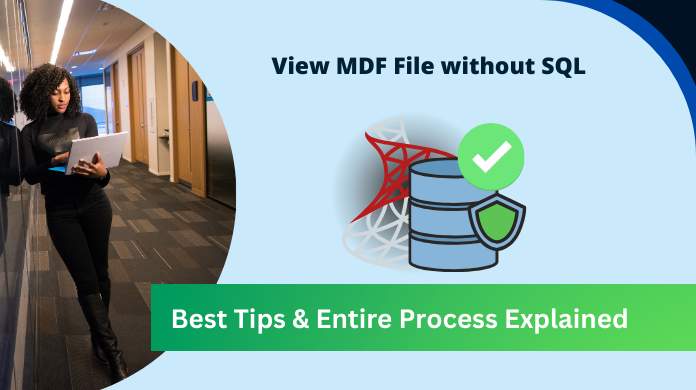View SQL Database Tables without SQL Server in Use
SQL Server database is nowadays quite common for storing databases. As a result, job opportunities are also emerging in this field. However, new users are not that much proficient in SQL technicalities in general. Therefore, we received queries from new users of the SQL database. They all are asking to view SQL database tables without having the SQL database in the system. Well, let’s begin the article & understand the anatomy behind this.
Viewing the SQL table data files without having SQL installed on SQL Server is quite difficult for users. Therefore, this article is intended to provide users with the best-in-class solution to get the desired results without any hassles at all. Moreover, along with the manual & automated solutions, this article also consists of the reasons that can help users understand the entire scenario deeply.
Last but not least, the advantages & drawbacks of the given solutions are also there. This way, users can get help in deciding the best possible solution as per their requirements.
Reasons to View SQL Table Data without Server Installation
There are plenty of causes that we can address why users need to view their database files without installing the SQL Server. Now, if we can understand these causes deeply, finding the solutions can be much easier.
No SQL Server in System: There are scenarios when users do not have an SQL Server in their system due to several reasons.
Complex Manual Solution: There are issues with the manual method as it is quite complex. Therefore, users require a solution without the use of SQL Server.
Lacking Modern Features: The usual methods lack modern-day features & this is why users need to be aware of the right solution.
Moreover, there are several other causes as well like having a corrupted database in the SQL server, etc. Let’s begin with the advanced automated solution to provide users with accurate results.
View SQL Database Tables Automatically
The advanced & reliable MDF Viewer Tool by SysTools can help users easily open MDF file & read the entire data inside. The automated tool is often recommended by IT experts as well as SQL MVPs. The reason expers suggest this utility is because of the advanced features present here.
Download the software & then go through the easy steps to get expected results in minimum time possible:
Step-1. Launch the Automated Tool in the system to begin.
Step-2. Click on the Open button to Add SQL MDF files.
Step-3. Select the Quick or Advance Scan mode here.
Step-4. Now, Wait until software completes the scan.
Step-5. Finally, Preview database files as needed.
Now, that we are well aware of the automated solution, it’s time that we focus on the features that this utility offers to users.
- Open & view tables, columns, triggers, stored procedures, views, rules, keys, classes, indexes, etc data objects.
- Allow users to scan MDF data with two scan modes. Quick scan mode for file scanning & advanced scanning for corrupted files.
- The automated tool comes with a pro version that can export the data in multiple formats like CSV, Script file, & SQL Server.
- MDF Viewer can help users view MDF data even after getting severely corrupted or damaged due to viruses, SQL injection attacks, etc.
- This software auto-detects the SQL Server version based on the MDF and NDF files uploaded by the users.
- There is no need ofr users to install SQL Server in their system. Also the GUI of automated tool is very interactive.
- Deleted Data in MDF files can also be viewed with this advanced utility. It shows that data in Red color as a highlight.
- The software supports SQL Server 2022, 2019, 2017, 2016, 2014, 2012, 2008/R2, 2005, & 2000 versions.
- Windows OS 11, 10, 8, 7, etc. along with Windows Server 2012, 2016, etc., are compatible with this tool.
How to View SQL Database Tables with Manual Methods
The manual method to view the MDF files includes the use of the SSMS & T-SQL methods. This means users need to have SQL Server installed on their servers. Well, the process does not guarantee users the expected results but they can opt for this in case they do not have any other option.
SQL Server Management Studio SSMS Method:
- Open SQL Server Management Studio in the system.
- Connect to the SQL Server Instance with the attached MDF data file.
- In Object Explorer, Expand “Databases” node & Select attached Database.
- Go to the “Tables” node, and you’ll get to see a list of tables within your database.
- Right-click on a Table and choose “Select Top 1000 Rows” or “Edit Top 200 Rows” to read the data inside them.
T-SQL Command Method:
To execute this task manually, users need to be proficient in T-SQL commands. Just run the following command in your SQL Server:
USE [Name_Of_Database]
SELECT * FROM [YourTableName]
Now that we are well aware of this manual method as well, it’s time that we go for the drawbacks present in this manual solution. This can help users to get a detailed understanding of the entire method.
Manual Method Drawbacks to View SQL Table Data
The manual solution to view SQL database tables is full of critical drawbacks & users should be aware of them. This is necessary to prepare for the upcoming challenges & hassles in advance. As we can not mention all of the drawbacks, we’re listing only the most common ones.
No Surety of Getting Expected Results: The manual solution is quite unstable. This is why users must understand that there is no surety of getting the expected results here.
Severe Data Corruption Issues: Users need to be aware of the fact that they can have severe data corruption issues with manual solutions.
Risk of Complete Data Loss: Apart from data corruption, the risk of total data loss is also there for users in this solution.
Lack of Advanced Features: The manual solution can often result in poor efficiency as these methods are long & lack advanced features.
Poor GUI of the Software: Poor & non-interactive GUI can make users bored with the manual solution & ultimately execute any mistake that can be risky.
The Final Say
As we have gone through both the manual & automated solutions, here we are at the conclusion. We can say that now we know how to view SQL database tables without errors. Now, the question is which solution is better for user-specific needs.
Well, we can say that as per experts & statistics, the automated solution is ideal for everyone. However, the manual solution comes with several limitations. Therefore, only users with expert-level technical knowledge should opt for them. Otherwise, the automated solution is always there.




